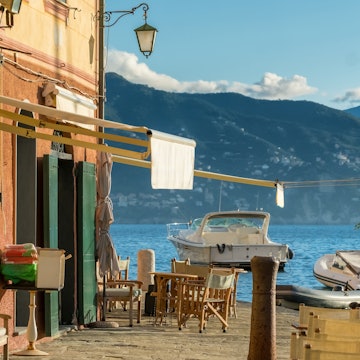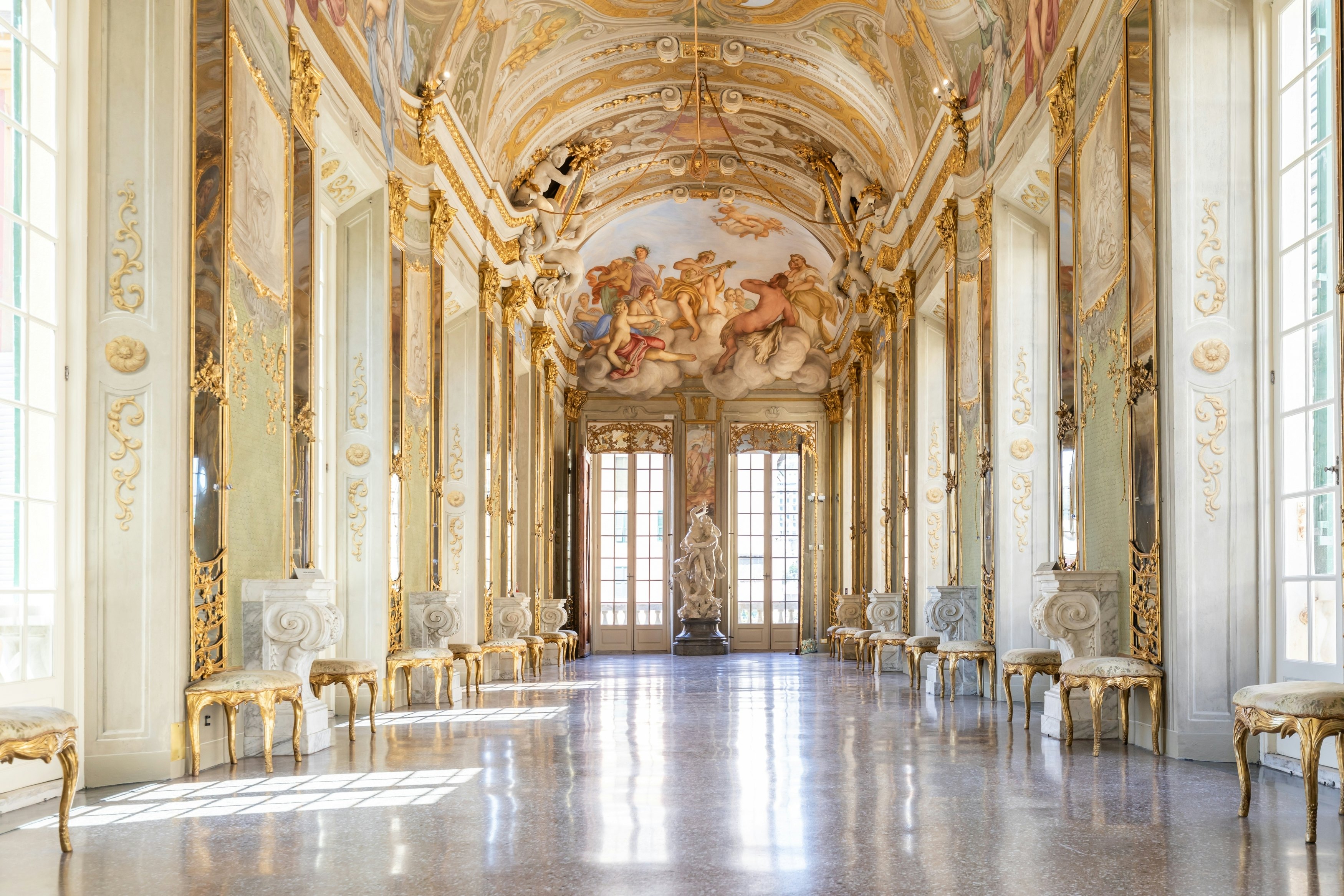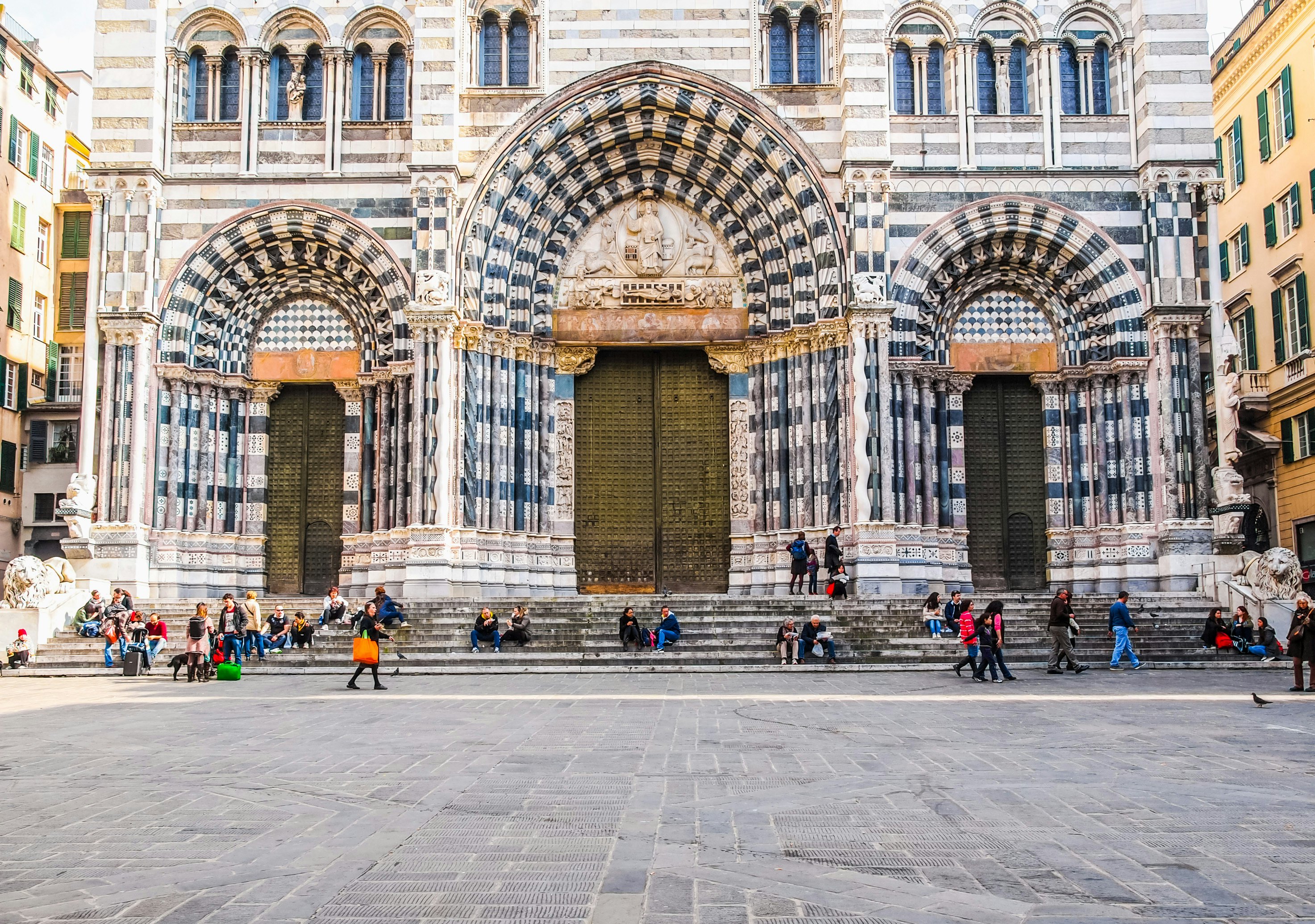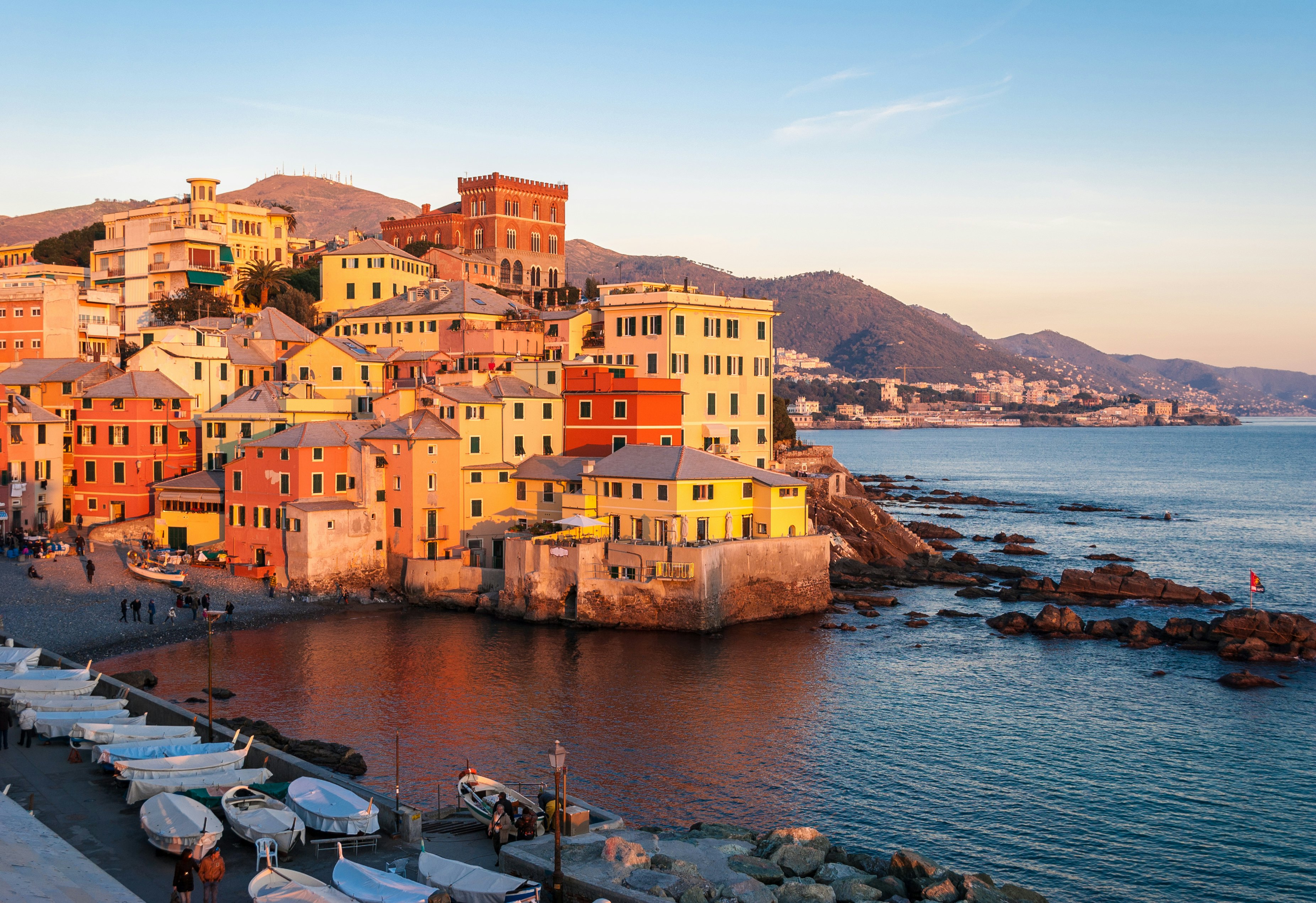

Piazza de Ferrari, Genoa. saiko3p/Shutterstock
Welcome to Genoa, the cultural capital of the Italian Riviera, where history feels alive. This port city – the largest in Italy – was a powerful maritime republic in the 12th to 13th centuries and one of Europe's richest places. Its extensive medieval old town is remarkably intact, with a twisting maze of narrow streets to explore, and its weighty architectural heritage is seen in its Renaissance palaces, baroque churches and grand piazzas. Explore the best of this fascinating city with these unmissable experiences.

1. Pause in the Piazza de Ferrari
Easily Genoa’s grandest square, this bright Parisian-like piazza, with its graceful fountain, offers visual relief for visitors emerging from the cramped confines of the caruggi (narrow streets). It’s bordered by a ring of prestigious buildings including the neo-Grecian Teatro Carlo Felice, the neoclassical Palazzo Ducale, host to international-caliber exhibitions, and the curvaceous Liberty-style Palazzo della Borsa, former home of the city’s stock exchange.
Planning tip: There are several square-side cafes where you can enjoy an elongated pausa (break).

2. Go on an art tour in the opulent Rolli palaces
The Rolli palaces are Genoa’s pièce de résistance, a network of opulent residences that belonged to the Genovese nobility during the age of the Republic and hosted visiting dignitaries on behalf of the government. One hundred and sixty three of these resplendent houses remain intact and, in 2006, 42 of them were recognized by UNESCO for their historical value. Around a dozen are open to visitors.
Three of these palazzi – Rosso, Bianco and Doria-Tursi – today comprise the Musei di Strada Nuova. In Palazzo Blanco, you'll find Flemish, Spanish and Italian artists on show, including Caravaggio’s Ecce Homo, Rubens’ Venere e Marte (Venus and Mars) and Van Dyck’s Vertumno e Pomona. The Palazzo Reale, a former residence of the Savoy dynasty, is Genoa’s proverbial Versailles with terraced gardens, exquisite furnishings, a fine collection of 17th-century Genovese art and a gilded Hall of Mirrors eerily redolent of its French counterpart. Palazzo Doria-Tursi, the largest of the Rolli palaces, also serves as Genoa’s town hall and visitors are free to wander around the courtyard and admire the outdoor terraces and grandiose staircases.
Planning tip: A joint ticket for the three Musei di Strada Nuova (Palazzos Bianco, Doria-Tursi and Rosso) costs €9 in person, or €10 if you purchase it online. However, you can visit parts of the Doria-Tursi for free, including the courtyard.

3. Experience Genovese trattorias
Super-cheap, perennially busy, and loved by a loyal audience of hungry locals who drop by daily to share gossip and order three courses and a jug of wine for lunch, trattorias define Genoa as much as the cross of St George and the Palazzi Rolli. Most of them have been around forever. By the port, Osteria di Vico Palla is so old, Flemish painter Van Dyck once stopped by for his evening repast. Trattoria della Raibetta near the cathedral has been grinding pine nuts and basil since 1700. Some only open for lunch, others have long lines. All serve the hallowed classics of Genovese cooking: trofie with pesto, pansotti (herb-filled ravioli) with walnut sauce, minestrone soup, coniglio (rabbit) ragu, farinata (chickpea pancakes), vegetable pies and anchovies done multiple ways.
Planning tip: The caruggi hosts the best of the crop, particularly the southeastern section around Piazza Cavour. Try Trattoria delle Grazie or join the line outside Cavour 21.

4. Explore the eclectic art of Castello d’Albertis
Dating from the late 1880s, this neogothic Xanadu in the Castelletto neighborhood was built to resemble a castle by Italian navigator, writer and philanthropist Enrico d’Albertis. Its museum houses a wide array of ethnographic artifacts from around the globe amassed by D’Albertis during his extensive travels. The bright galleries cover the map from pre-Columbian pottery to traditional medicines of the Far East. A leafy terrace by the entrance offers seagull-eye views over the city.
Planning tip: The castle is a short steep climb from Stazione Piazza Principe or save your legs by taking the Ascensore Montegalletto.

5. Get disorientated in the caruggi of the Old City
Many Italian cities are crisscrossed by dark medieval streets, but none are as labyrinthine as Genoa’s. The Ligurian capital’s famous caruggi (narrow streets) comprise a shadowy, hard-to-navigate web of twisting lanes and sun-starved back alleys in the Old City, some so narrow that residents can literally lean out and fist bump their neighbors across the street.
For visitors, it’s practically impossible to follow a prearranged itinerary. Instead, succumb to spontaneous adventure as you dip intermittently into noisy trattorias and niche century-old shops before being spat out in a cramped piazza adorned with an extravagantly frescoed church or an ornate palace.
Planning tip: Places worth lingering in this close-knit, tightly coiled quarter include Piazza Campetto whose erstwhile palaces have been turned into boho bars and shops, Basilica di San Siro, its sober classical facade obscuring a dazzlingly baroque interior, and Caffè degli Specchi where Italian poet Dino Campana once knocked back espressos while scribbling his elegiac musings.

6. Enjoy panoramic city views from the Spianata Castelletto
Once outside the city but, these days, very much inside it, this superb viewpoint is a short, steep walk or quick elevator ride from Via Garibaldi. The broad Spianata (esplanade) at the top is lined by palms and reveals the natural amphitheater of Genoa in all its glory clustered around its harbor. A once sturdy castelletto (little castle) was removed in the 19th century.
Planning tip: Get there via the art-nouveau lift on the Piazza del Portello, or take the steep lane/staircase of Salita San Gerolamu.

7. Explore one of Italy's most curious cathedrals
Even if you’ve had your fill of Italian churches, Genoa’s Cattedrale di San Lorenzo deserves a good hour’s examination. A curious mix of two competing medieval architectural styles, Romanesque and Gothic, it owes its continued existence to the poor quality of a British bomb that failed to ignite in 1941 after being fired from a ship in the harbor. The offending trajectile is displayed on the right side of the nave like a macabre museum exhibit.
Fronted by Gothic portals, twisting columns and crouching lions, the cathedral was consecrated in 1118 but mostly rebuilt in the 1300s. The sacristy guards the Museo del Tesoro, an unlikely treasure box that preserves several holy relics of questionable provenance. Come here to view the medieval Sacro Catino, a glass vessel once thought to be the Holy Grail; the polished quartz platter upon which King Herod’s stepdaughter, Salome, is said to have received John the Baptist’s head; and fragments of the "True Cross" embedded into the Byzantine Cross of Zaccarias.

8. Wander the Porto Antico
Genoa’s Porto Antico is the city waterfront stretching from Lanterna di Genova (a 76m lighthouse built in 1563) to Palazzo San Giorgio. Along the route, explore the Galata Museo del Mare where you can enjoy four floors of exhibits in an exhaustive study of Genoa's maritime history with mock-ups of old galleys and galleons, or visit the Neptune, a reproduction 17th-century galleon used in films and beloved by kids. The Aquarium, Europe’s second largest, houses 400 marine species across 70 tanks, while the nearby Biosfera is a striking bubble-shaped glass structure with animals and plants. The walk ends at Palazzo San Giorgio (constructed in 1260), which features St George beneath its clock and depicts famous Genoese natives, including Christopher Columbus.

9. Hike Genoa's outlying forts
As a powerful city state, Genoa historically sought protection behind a formidable system of walls and forts built and rebuilt in various guises from the 9th century onwards. The most ambitious bastions, the so-called "New Walls," were built from 1626–39. Several of these forts remain intact and can be explored on a 3-hour circular hike from Parco delle Mura. Start with a 10-minute funicular ride from Zecca up to Righi, then follow a paved road to the protected park. Castellaccio, the first fort, has a small roadside cafe and serves as a good orientation point. From here, continue to the well-preserved Forte Begato and Forte Sperone (both from the 1820s), then north along a ridge past privately owned Forte Puin to Forte Diamante (1756), a striking hilltop fort perched at 667m.
Planning tip: Though currently closed, the forts are close enough to explore their historic walls, offering superb views of the surrounding hills and Genoa below. The trails wind through sun-dappled woodland and grassland abundant with butterflies in summer.

10. Watch the sun go down in Boccadasse
When the day begins to wane, do as the Genovese do and join the passeggiata – evening stroll – along the oceanside promenade, Corso Italia, which begins around 3km east of Genoa’s city center. This broad 2.5km-long pavement lined with flamboyant villas and expensive beach clubs ends at Boccadasse, a once separate fishing village that glimmers like an outlying Cinque Terre member. Its sheltered beach is perfect gelato-licking territory, and its gaggle of sea-grizzled bars is an ideal spot to chink glasses as the sun winks goodnight.
Planning tip: Bus No 42 goes to Boccadasse from Via Dante near the De Ferrari metro station. Bus 31 also goes there from Brignole Station.
















